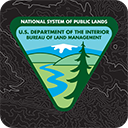Since its passage in 1976, FLPMA has helped the BLM meet the moment
By Derrick Henry, Public Affairs Specialist
The Federal Land Policy and Management Act, or FLPMA, acts as the Bureau of Land Management’s operating system to manage more than 245 million acres of public land and 700 million acres of sub-surface mineral estate throughout the nation. Passed by Congress in 1976 and signed into law October 21st of that year, this legislation gives the BLM the authority to do most of its daily work.
FLPMA is central to our management of public lands for outdoor recreation, energy development, livestock grazing, mining, and timber harvesting, while conserving natural, historical, and cultural resources such as wilderness areas, wild horse and wildlife habitat, artifacts, and dinosaur fossils. Our FLPMA-compliant management decisions generate significant economic output. In fiscal year 2021, BLM-authorized activities on public lands generated $201 billion in economic output and supported nearly 783,000 jobs across the country.
Recent developments show how FLPMA enables the BLM to manage according to shifting needs and priorities for the American people.
First, though deadly, the COVID pandemic corresponded with more visits to public lands for outdoor recreation. In 2020, there were more than 73 million recreation-related visits to public lands, an increase of about 3 percent over the previous year. In 2021, that figure was more than 80 million, an increase of about 10 percent over 2020. Through FLPMA authorities, BLM employees continued to manage lands for recreation, meeting the increased demand with an emphasis on public health and safety. It’s likely the demand will persist; those new visitors now know that more than 99 percent of BLM lands are available for recreation at no fee.
Second, the BLM is using various authorities under FLPMA to implement Joint Secretarial Order 3403, a “Tribal Homelands Initiative” intended to improve federal stewardship of public lands by strengthening the role of Tribal governments in federal land management. The order builds on the historic agreement between the BLM and five Tribal Nations on the co-management of the Bears Ears National Monument in Utah. In implementing the order, the BLM has available various FLPMA authorities to support co-stewardship activities. This includes issuing easements, permits, leases, or rights of-way in appropriate circumstances to facilitate Tribal activities on public lands.
And finally, FLPMA helps the BLM facilitate renewable energy projects. Under FLPMA, the BLM can authorize rights-of-way on public lands for generation, transmission, and distribution of electric energy. Renewables support the administration’s climate initiatives, and the BLM has been working to expand development of wind, solar and geothermal energy sources on public lands. Through fiscal year 2021, the BLM has approved 38 solar and 36 wind energy projects with a capacity of more than 10,000 megawatts. There are also 47 operating geothermal power plants with a capacity of approximately 2,500 megawatts.
In these three areas, the BLM has used FLPMA’s management authorities to meet shifting needs and new initiatives. This alongside peerless, ongoing land management work done by 10,000 agency employees.
After Congress passed FLPMA and it became law, the BLM’s approach was formalized into a comprehensive authority and guidelines for the management and protection of public lands and their resources. Since then, this powerful and adaptive tool has been used to advance our core mission — a careful balancing of multiple use and sustained yield to meet current and future needs.
Learn more about FLPMA and our other legal authorities on our website.
